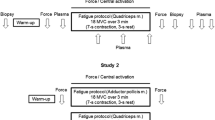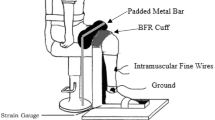Abstract
Purpose
This study examined whether changes in pH throughout the physiologic range would have a differential effect on central and peripheral factors associated with fatigue and force production during submaximal lower limb isometric exercise to task failure.
Methods
Eight males completed three experimental trials [0.2 g kg−1 ammonia chloride (ACD); 0.3 g kg−1 calcium carbonate (PLA); or 0.3 g kg−1 sodium bicarbonate (ALK)], each consisting of submaximal calf contractions at 55 % of maximal voluntary contraction (MVC) to task failure. Every minute of the task subjects performed an MVC, coupled with stimulation of the tibial nerve during and immediately post MVC.
Results
Time to task failure was not different between trials (ACD 531 ± 166 s, PLA 592 ± 163 s, ALK 596 ± 150 s; p = 0.31). MVC force in all trials declined 29 % from the start of exercise to the fifth minute (mean decline of 371 ± 26 N; p < 0.001), however was not different between trials (p = 0.21). Fatigue was mediated in all trials by central and peripheral factors, as declines in voluntary activation, V/M-wave in the soleus and the potentiated resting twitch amplitudes were evident throughout the task (p < 0.05). Central fatigue appeared to be muscle specific, as reductions in central drive (V/M-wave and rate of sEMG rise) persisted in the soleus but not the medial gastrocnemius.
Conclusions
These data suggest that calf fatigue associated with intermittent, isometric contractions to task failure is unaffected by alterations in pH; however, central drive reductions may be muscle specific.



Similar content being viewed by others
Abbreviations
- ACD:
-
Acidosis
- ADP:
-
Adenosine diphosphate
- ALK:
-
Alkalosis
- NH4Cl:
-
Ammonium chloride
- BE:
-
Base excess
- HCO3 :
-
Bicarbonate
- BW:
-
Body weight
- Ca+ :
-
Calcium
- Cl− :
-
Chloride
- CI:
-
Confidence interval
- Pi:
-
Inorganic phosphate
- Mmax:
-
M-wave
- MG:
-
Medial gastrocnemius
- MVC:
-
Maximal voluntary contraction
- PLA:
-
Placebo
- K+ :
-
Potassium
- RT:
-
Resting potentiated twitch
- RER:
-
Rate of sEMG rise
- RFD:
-
Rate of force development
- Na+ :
-
Sodium
- NaHCO3 :
-
Sodium bicarbonate
- SOL:
-
Soleus
- sEMG:
-
Surface electromyography
- VA:
-
Voluntary activation
References
Aagaard P, Simonsen EB, Andersen JL et al (2002) Neural adaptation to resistance training: changes in evoked V-wave and H-reflex responses. J Appl Physiol 92:2309–2318. doi:10.1152/japplphysiol.01185.2001
Allen DG, Lamb GD, Westerblad H (2008a) Impaired calcium release during fatigue. J Appl Physiol 104(1):296–305
Allen DG, Lamb GD, Westerblad H (2008b) Skeletal muscle fatigue: cellular mechanisms. Physiol Rev 88:287–332. doi:10.1152/physrev.00015.2007
Allison GT (2003) Trunk muscle onset detection technique for EMG signals with ECG artefact. J Electromyogr Kinesiol 13(3):209–216
Amann M (2012) Significance of group III and IV muscle afferents for the endurance exercising human. Clin Exp Pharmacol Physiol 39:831–835. doi:10.1111/j.1440-1681.2012.05681.x
Amann M, Venturelli M, Ives SJ et al (2013) Peripheral fatigue limits endurance exercise via a sensory feedback-mediated reduction in spinal motoneuronal output. J Appl Physiol 115:355–364. doi:10.1152/japplphysiol.00049.2013
Andersen LL, Aagaard P (2006) Influence of maximal muscle strength and intrinsic muscle contractile properties on contractile rate of force development. Eur J Appl Physiol 96(1):46–52. doi:10.1007/s00421-005-0070-z
Benadé AJ, Heisler N (1978) Comparison of efflux rates of hydrogen and lactate ions from isolated muscles in vitro. Respir Physiol 32:369–380
Broch-Lips M, Overgaard K, Praetorius HA et al (2007) Effects of extracellular HCO3 on fatigue, pHi, and K+ efflux in rat skeletal muscles. J Appl Physiol 103:494–503. doi:10.1152/japplphysiol.00049.2007
Brody LR, Pollock MT, Roy SH et al (1991) pH-induced effects on median frequency and conduction velocity of the myoelectric signal. J Appl Physiol 71:1878–1885
Brooks C, Kennedy S, Marshall PW (2012) Specific trunk and general exercise elicit similar changes in anticipatory postural adjustments in patients with chronic low back pain: a randomized control trial. Spine 37(25):E1543–E1550. doi:10.1097/BRS.0b013e31826feac0
Buckthorpe M, Pain MTG, Folland JP (2014) Central fatigue contributes to the greater reductions in explosive than maximum strength with high intensity fatigue. Exp Physiol 99(7):964–973. doi:10.1113/expphysiol.2013.075614
Cairns SP, Dulhunty AF (1995) High-frequency fatigue in rat skeletal muscle: role of extracellular ion concentrations. Muscle Nerve 18(8):890–898
Cairns SP, Lindinger MI (2008) Do multiple ionic interactions contribute to skeletal muscle fatigue? J Physiol 586(Pt 17):4039–4054. doi:10.1113/jphysiol.2008.155424
Carr AJ, Hopkins WG, Gore CJ (2011) Effects of acute alkalosis and acidosis on performance: a meta-analysis. Sports Med 41:801–814. doi:10.2165/11591440-000000000-00000
Churchward-Venne TA, Kowalchuk JM, Marsh GD (2010) Effects of ammonium chloride ingestion on phosphocreatine metabolism during moderate- and heavy-intensity plantar-flexion exercise. Eur J Appl Physiol 108(6):1189–1200. doi:10.1007/s00421-009-1327-8
Debold EP, Beck SE, Warshaw DM (2008) Effect of low pH on single skeletal muscle myosin mechanics and kinetics. Am J Physiol Cell Physiol 295(1):C173–C179. doi:10.1152/ajpcell.00172.2008
Debold EP, Longyear TJ, Turner MA (2012) The effects of phosphate and acidosis on regulated thin-filament velocity in an in vitro motility assay. J Appl Physiol 113(9):1413–1422. doi:10.1152/japplphysiol.00775.2012
Edman KA, Mattiazzi AR (1981) Effects of fatigue and altered pH on isometric force and velocity of shortening at zero load in frog muscle fibres. J Muscle Res Cell Motil 2:321–334
Egaña M, Green S (2006) Intensity-dependent effect of body tilt angle on calf muscle fatigue in humans. Eur J Appl Physiol 99:1–9. doi:10.1007/s00421-006-0308-4
Fitts RH (2011) New insights on sarcoplasmic reticulum calcium regulation in muscle fatigue. J Appl Physiol 111:345–346. doi:10.1152/japplphysiol.00720.2011
Gabriel DA, Kamen G, Frost G (2006) Neural adaptations to resistive exercise: mechanisms and recommendations for training practices. Sports Med 36(2):133–149
Gandevia SC (2001) Spinal and supraspinal factors in human muscle fatigue. Physiol Rev 81:1725–1789
Green S, Langberg H, Skovgaard D et al (2000) Interstitial and arterial-venous [K+] in human calf muscle during dynamic exercise: effect of ischaemia and relation to muscle pain. J Physiol 529(Pt 3):849–861. doi:10.1111/j.1469-7793.2000.00849.x
Hahn D, Hoffman BW, Carroll TJ et al (2012) Cortical and spinal excitability during and after lengthening contractions of the human plantar flexor muscles performed with maximal voluntary effort. PLoS One 7(11):e49907. doi:10.1371/journal.pone.0049907
Higgins MF, Tallis J, Prices MJ et al (2013) The effects of elevated levels of sodium bicarbonate (NaHCO3) on the acute power output and time to fatigue of maximally stimulated mouse soleus and EDL muscles. Eur J Appl Physiol 113(5):1331–1341. doi:10.1007/s00421-012-2557-8
Jankowski MP, Rau KK, Ekmann KM et al (2013) Comprehensive phenotyping of group III and IV muscle afferents in mouse. J Neurophysiol 109:2374–2381. doi:10.1152/jn.01067.2012
Johnson MA, Polgar J, Weightman D et al (1973) Data on the distribution of fiber types in thirty-six human muscles. An autopsy study. J Neurol Sci 19(3):307–318
Knuth ST, Dave H, Peters JR et al (2006) Low cell pH depresses peak power in rat skeletal muscle fibres at both 30 degrees C and 15 degrees C: implications for muscle fatigue. J Physiol 575(Pt 3):887–899
Levraut J, Labib Y, Chave S et al (1996) Effect of sodium bicarbonate on intracellular pH under different buffering conditions. Kidney Int 49:1262–1267
Light AR, Hughen RW, Zhang J et al (2008) Dorsal root ganglion neurons innervating skeletal muscle respond to physiological combinations of protons, ATP, and lactate mediated by ASIC, P2X, and TRPV1. J Neurophysiol 100:1184–1201. doi:10.1152/jn.01344.2007
Linderman JK, Gosselink KL (1994) The effects of sodium bicarbonate ingestion on exercise performance. Sports Med 18:75–80
Martin PG (2006) Fatigue-sensitive afferents inhibit extensor but not flexor motoneurons in humans. J Neurosci 26:4796–4802. doi:10.1523/JNEUROSCI.5487-05.2006
Martin PG, Weerakkody N, Gandevia SC et al (2008) Group III and IV muscle afferents differentially affect the motor cortex and motoneurones in humans. J Physiol 586:1277–1289. doi:10.1113/jphysiol.2007.140426
McNaughton LR, Siegler J, Midgley A (2008) Ergogenic effects of sodium bicarbonate. Curr Sports Med Rep 7:230–236. doi:10.1249/JSR.0b013e31817ef530
Merton PA (1954) Interaction between muscle fibres in a twitch. J Physiol 28(2):311–324
Millet GY, Martin V, Martin A et al (2011) Electrical stimulation for testing neuromuscular function: from sport to pathology. Eur J Appl Physiol 111:2489–2500. doi:10.1007/s00421-011-1996-y
Overgaard K, Højfeldt GW, Nielsen OB (2010) Effects of acidification and increased extracellular potassium on dynamic muscle contractions in isolated rat muscles. J Physiol 15(588 Pt 24):5065–5076. doi:10.1113/jphysiol.2010.195727
Peart DJ, Siegler JC, Vince RV (2012) Practical recommendations for coaches and athletes: a meta-analysis of sodium bicarbonate use for athletic performance. J Strength Cond Res 26:1975–1983. doi:10.1519/JSC.0b013e3182576f3d
Pedersen TH, Nielsen OB, Lamb GD et al (2004) Intracellular acidosis enhances the excitability of working muscle. Science 305(5687):1144–1147
Raymer GH, Marsh GD, Kowalchuk JM et al (2004) Metabolic effects of induced alkalosis during progressive forearm exercise to fatigue. J Appl Physiol 96:2050–2056. doi:10.1152/japplphysiol.01261.2003
Robergs R, Hutchinson K, Hendee S et al (2005) Influence of pre-exercise acidosis and alkalosis on the kinetics of acid-base recovery following intense exercise. Int J Sport Nutr Exerc Metab 15(1):59–74
Rotto DM, Kaufman MP (1988) Effect of metabolic products of muscular contraction on discharge of group III and IV afferents. J Appl Physiol 64:2306–2313
Siegler JC, Midgley AW, Poman RC et al (2010) Effects of various sodium bicarbonate loading protocols on the time-dependent extracellular buffering profile. J Strength Cond Res 24(9):2551–2557. doi:10.1519/JSC.0b013e3181aeb154
Siegler JC, Marshall PWM, Raftry S et al (2013) The differential effect of metabolic alkalosis on maximum force and rate of force development during repeated, high-intensity cycling. J Appl Physiol 115:1634–1640. doi:10.1152/japplphysiol.00688.2013
Sostaric SM, Skinner TLSL, Brown MJ et al (2005) Alkalosis increases muscle K+ release, but lowers plasma [K+] and delays fatigue during dynamic forearm exercise. J Physiol 570:185–205. doi:10.1113/jphysiol.2005.094615
Strojnik V, Komi PV (1998) Neuromuscular fatigue after maximal stretch-shortening cycle exercise. J Appl Physiol 84:344–350
Trappe SW, Trappe TA, Lee GA et al (2001) Calf muscle strength in humans. Int J Sports Med 22(3):186–191
Van Cutsem M, Duchateau J, Hainaut K (1998) Changes in single motor unit behaviour contribute to the increases in contraction speed after dynamic training in humans. J Physiol 513(1):295–305
Vasuvattakul S, Warner LC, Halperin ML (1992) Quantitative role of the intracellular bicarbonate buffer system in response to an acute acid load. Am J Physiol 262:R305–R309
Vila-Cha C, Falla D, Correia MV et al (2011) Changes in H reflex and V wave following short-term endurance and strength training. J Appl Physiol 112:54–63. doi:10.1152/japplphysiol.00802.2011
Zhang SJ, Bruton JD, Katz A et al (2006) Limited oxygen diffusion accelerates fatigue development in mouse skeletal muscle. J Physiol 572:551–559. doi:10.1113/jphysiol.2005.104521
Acknowledgments
The authors would like to acknowledge Bulk Nutrients™ for supplying the carbohydrate and protein powders for the standardized pre-exercise meal replacement shake. Additional support was also provided by the University of Western Sydney’s School of Science and Health’s New Research Project Development Grant (NRPDG) scheme.
Author information
Authors and Affiliations
Corresponding author
Additional information
Communicated by Nicolas Place.
Rights and permissions
About this article
Cite this article
Siegler, J.C., Marshall, P., Pouslen, M.K. et al. The effect of pH on fatigue during submaximal isometric contractions of the human calf muscle. Eur J Appl Physiol 115, 565–577 (2015). https://doi.org/10.1007/s00421-014-3027-2
Received:
Accepted:
Published:
Issue Date:
DOI: https://doi.org/10.1007/s00421-014-3027-2




